If you are reading this it means that you are about to bring a new addition into your family. Congratulations! But there may be other members of your already established family who aren’t as excited about it as you are. In many ways, your dog was your first child. Many couples test their parenting abilities and the balance of work with a reliant mouth to feed at home. While it is a tried and true way to balance those responsibilities, it can also pose a new challenge when you bring home your new baby. Just like you treated your pup as your baby for so many years before introducing a real baby into the household, your dog has accepted the position as “mommy and daddies fur-baby”. They consider themselves important to the pack and respect you as their pack alpha. A new addition to the family can change that dynamic and has, in some cases, brought harm to that new baby being brought into the family. How to introduce a dog to a new baby is a vital part of being a pet owner; creating the right power dynamic and attitudes in the home once you have welcomed your new pack member to the family.
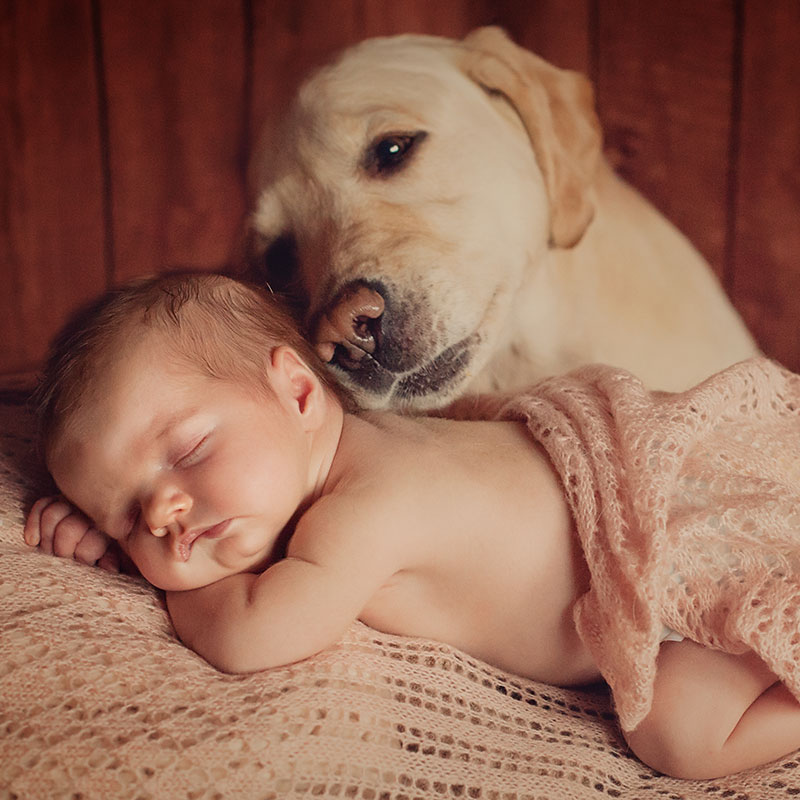
Start Preparing Early
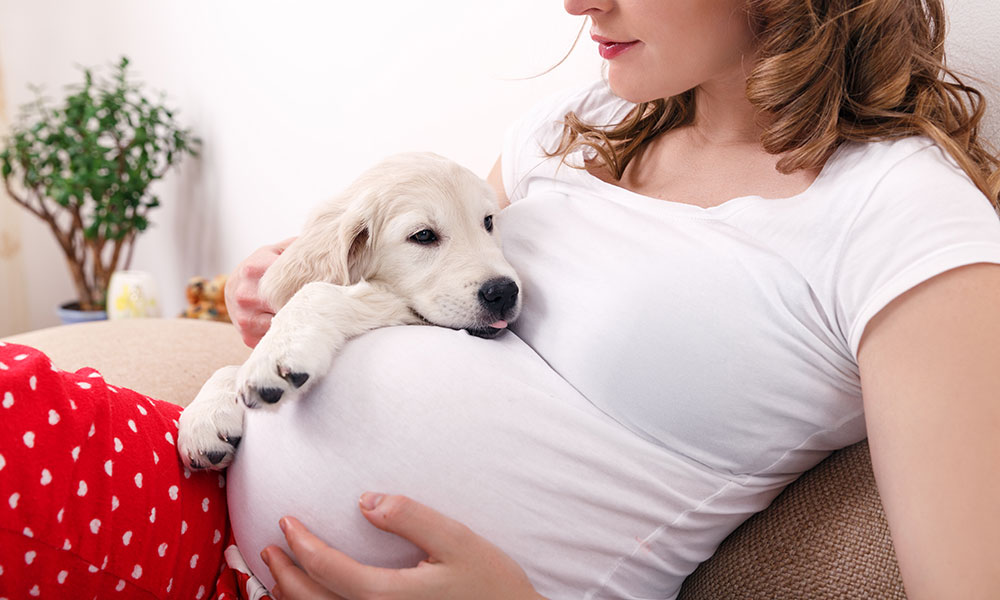
Like we mentioned before, having a pet is – kind-of – a testing ground for some couples. They are seeing how well they can balance the responsibilities of pet ownership and keeping them happy with the rest of their life. The “test” used to be: get a plant for a year, if it lives then get a fish. If that survives for a year, or six months, get a dog or cat. Gradually working your way up to a baby through responsibility and patience. Obviously 2 or more years of testing yourselves to be ready for a child isn’t always how life pans out.
The biggest misconception when it comes to an attack or ‘nip’ at a newborn is that the dog is violent or a violent breed. That is inaccurate. Whether you have had your pooch for 3 months, a year of 5 years, they have cemented their position in your pack and are wary of bringing in outsiders. To make this transition as easy as possible, you need to begin the training process as early as possible, too. Waiting until your baby is born is a bad time to break the news to your pup and the change that is about to come to their routines. At the end of the day, it’s the routine change that is the most jarring to the dog and can cause the issues to arise between them and your new baby. A good way to ease them into that transition is by making slight adjustments to their routine as early as 6-months before your baby is born. This can be as simple as introducing a stroller to your daily walks. You might get some odd looks from your neighbours or passing cars, but by the time he or she is born, your dog will be used to the extra “body” on their walk.
If you have a friend or family member with a young child, ask them if they’d be comfortable having you tag along for a stroll here and there. Scent plays a big role in acclimating your dog to the new family member, but your dog also has to learn how to act around a young child or newborn. Teaching them boundaries early is paramount. Simple dog commands like ‘back’ or ‘heel’ are great additions to this type of training. Bring some treats on those walks and reward them with praise when they don’t jump or get too close to the stroller. Over time, this will teach them to leave a respectable distance between them and the baby.
A Few Months Before
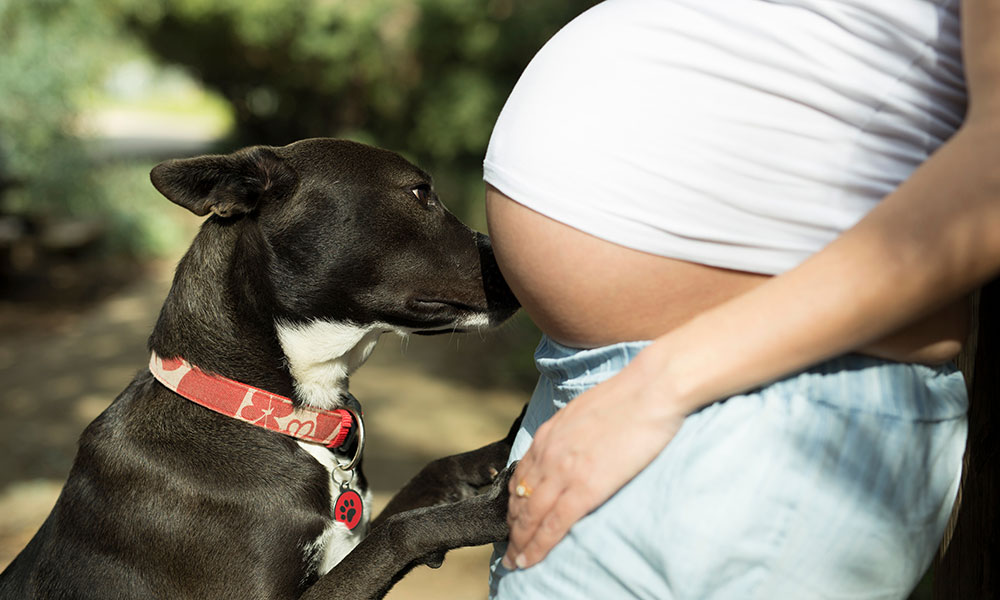
You are only a few months out now and soon you’ll have to prepare your dog for the baby. By this time, baby clothes, cribs, a nursery may already be “invading” your home. Creating boundaries becomes a very important step at this point. To avoid any future territory disputes or overstepping of those boundaries you’re trying to set with the dog, you will want to establish the nursery as a “no zone” for them. At least for the first few months. This will be another good place to utilize the ‘back’ command with your dog. When you are decorating or organizing the room, don’t allow your dog to cross the threshold. This will create an invisible barrier and teach them that this is not their space. We refer to your family as a pack a lot because your family is a pack in the eyes of your dog. Teaching these boundaries will help you enforce the fact that the newborn baby isn’t a threat, but a new addition to the pack and should be respected.
If your dog is proving to be slightly difficult to prepare for the baby, the option of doggy-daycare may be an option to explore. Some dogs are hyper-excited and, no matter how hard you try, don’t take well to commands. This is why the experts exist. At least in the beginning months. If this is something that you are concerned about, you can enrol them in a week, a month or a few months of doggy-daycare to ease the stress of a newborn baby and a curious pooch.
Slowly Introduce Them To Your New Baby’s Scent
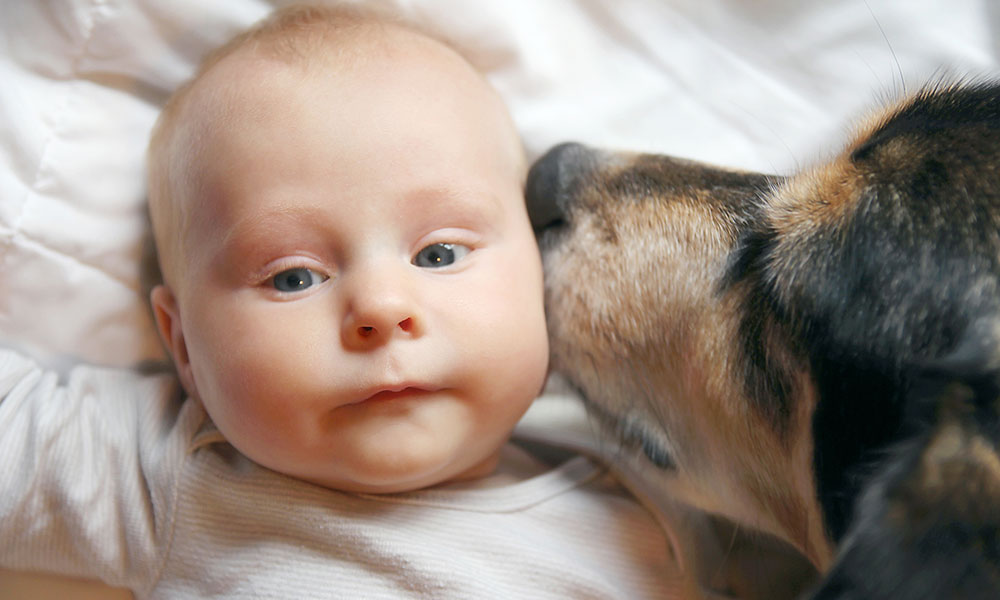
You have done as much as possible before the baby comes, but now they are here. He or she is healthy and in a few days you will be bringing them home. Now is the time to introduce the dog to your newborn baby’s scent. The first time you change your baby into a new jumper or want to change their blanket, take one of those items home. A common misconception is that a dog or a pet doesn’t like the new family member because they are jealous. If you have ever introduced a dog to another dog or cat, you know that is not true. It’s the new smells that trigger their aggression, curiosity or excitement. To introduce them properly, don’t shove a nose full of baby clothes into their face, rather introduce them to it from a distance. Again, dog treats are going to be your friend here.
With a handful of treats in one hand, and the jumper/blanket in another, hold it out and let your dog sniff it from a distance. If they run up to it too quickly, stop and restart. You want them to be as calm as possible and run this exercise as slowly as possible. Once your dog shows curiosity from a distance, and doesn’t rush the item of clothing, reward them with a treat. Now let them in a little closer. Treat. A little closer and – yes – another treat. Once you have repeated this exercise enough that they seem less curious about the smell and more accepting of it, you can either try a new article of clothing or blanket or let them in for a good sniff. Getting your dog used to the smell of the new family member will make it far less jarring when you bring home the real thing.
The First Meeting
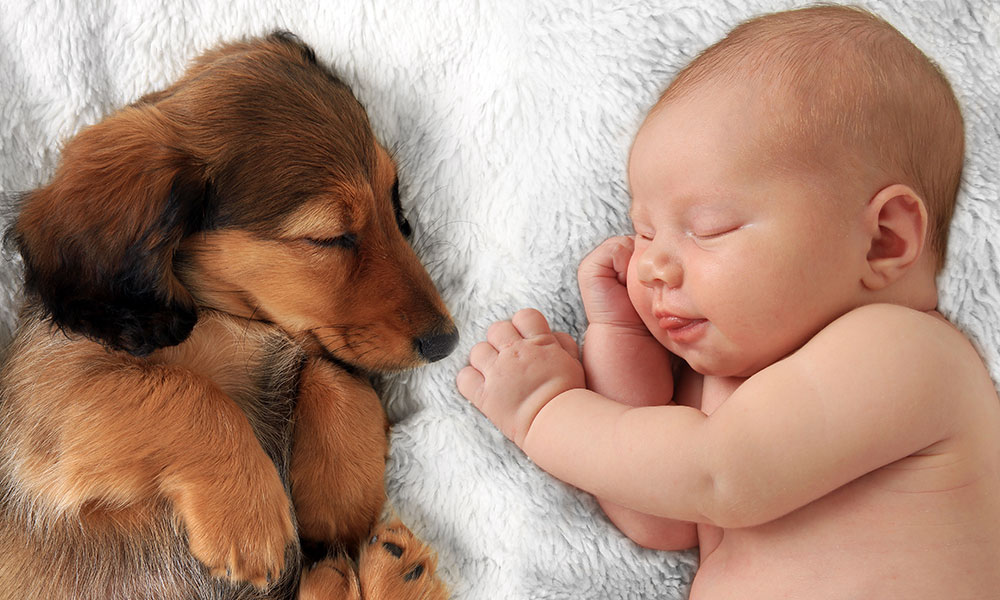
Even with all the practice and training beforehand, the real thing can still be stressful. When your baby is ready to come home you will want to handle it in a delicate way. The meeting needs to establish a few things. Firstly, the baby is YOUR property. They are a new member of the pack and your dog needs to recognize and respect the fact that, at the end of everything, the baby is yours. That respect will pay off later when your dog is aware not to overstep any boundaries.
A calm dog is imperative at this point. If at all possible, have a family friend or your partner take them for a walk or playtime before you try to introduce them to your baby. Before you bring in the newborn you want to greet your dog. Do this one at a time. It is not only a great way to help calm them, even though they will be excited to see mommy after a few days of them being gone, but it will remind the dog that they are still important. It will also help transfer the scent of newborn to them while attuning it to your own. Once fido is calm and ready, and you have both greeted them individually, it’s time to bring in the baby. At this time, you will repeat the same exercise you did with the blanket while mom was in the hospital. From a few feet away, let your dog sniff and get any curiosities out of the way. With a combination of the ‘back’ command and treats, keep them at a safe distance until you feel comfortable letting them in a bit closer. Repeat this until they are able to gently sniff the baby in your arms. A good way to do this and maintain control over your dog is to ensure they are on a leash during the interaction.
Ongoing Training
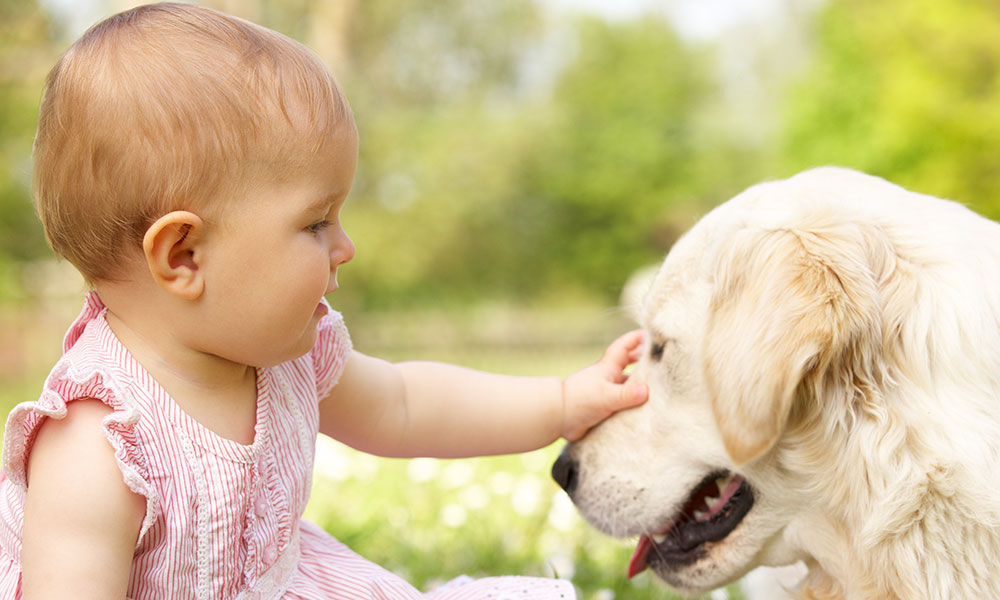
Training your dog to respect and accept your baby is an ongoing process. The main thing that jars your dog is the change to their routine. They are, at their core, creatures of habit. When do you normally walk, feed or play with your dog? Continue those habits to make it easier for them. Neglecting them for the baby is only going to create resentment for the new baby who is taking away all of their attention. If you continue things as normal, they will come to accept and respect the new pack member. Working your newborn into your dog’s routines will ease this transition as well. Taking your baby for a walk with your dog is a great way to let them get used to one another. Just ensure that they maintain a safe distance from the stroller and *do not* fasten the leash to the stroller. That decision could be one squirrel-chase away from disaster.
It’s not just your dog that needs to be trained from this point on. Your baby should be taught the proper way to interact with them. They are an animal and babies/toddlers are loud, random people. Teach your child how to properly pet them. Hold their hand and show them how mommy and daddy do it. Don’t allow them to try to ride on the dog. Don’t let them get too close to the dog or their favorite spots or their beds. You may think it’s cute but your dog is wondering why this new creature is trying to move in on their territory.
Conclusion
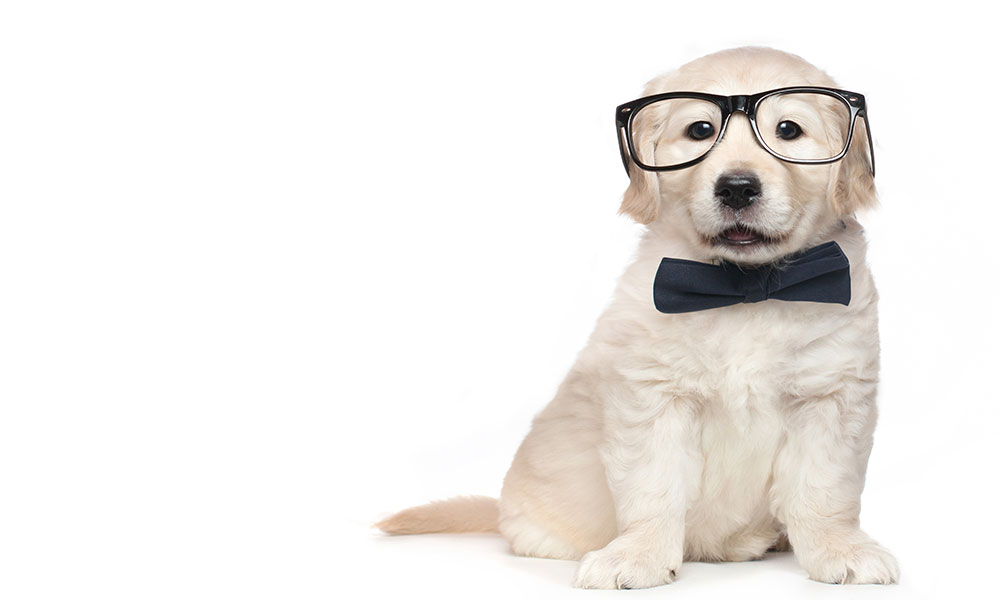
Owning a dog is a huge responsibility. You knew that when you got into pet ownership. Raising a well trained dog will only make life easier, especially when you are planning on bringing in another person into their world. Lots of owners fail to understand this when they are building a family, which is what usually leads to violent encounters between a dog and a newborn baby. This inadequate attention and training is what leaves parents with no other option than sending the family dog to a shelter. Our goal with this article is to avoid that from happening. If you follow these steps and prepare accordingly, there’s no doubt that your newborn baby and dog will be the best of friends in the future.
FAQ’s
Is it safe to have dogs around newborn babies?
In most cases, dogs and babies or young children can coexist quite well. However, to ensure that your baby and dog don’t cause each other stress or harm, it’s important that you pay close attention to your canine’s behavioral cues when they’re around your children. It’s important to slowly familiarize your baby and dog, be sure to not force interaction between the two if your baby and pets are showing signs of anxiety, and to try to involve your dog with baby-related care such as bring them with you on stroller walks, diaper changes, bedtime or leisure.
Can dogs get depressed with a new baby?
Introducing dogs to babies can lead to jealously, anxiety, depression and aggressive behaviors towards your new bundle of joy. To avoid your baby causing your dog to fall into a depressed funk, try your best to promote interaction between them, include your dog in many of your baby’s daily activities and reward your canine for positive behaviors towards your baby.
How do I train my dog for being around a new baby?
Introducing dogs to babies can go smoothly if you familiarize your dog with baby clothes, bedding, strollers/rockers, or other new items associated with your baby. Teaching your baby and dog to get along is greatly dependent on your ability to create a comfortable, safe, friendly and positive environment for both your baby and pets. Doing things like naptime together, including your dog in playtime, teaching your baby to reward your dog with petting or hugs, and always paying close attention to your dog’s nervousness can help to make your baby and dog best friends.
Can dogs sleep in the same room as a baby?
Babies and pets can certainly cohabitate together in peace, love and harmony – even when it comes to those sleepless nights in the early days of your infant’s development. Introducing your dog to your baby’s bedtime routine can help your canine to become familiar with your new schedule, but it can also provide your and your baby with some much needed comfort & cuddles on those sleepless nights. If your dog exhibits signs of stress or possessiveness over your bed, it’s best to put them out of the room and try again another time. As always, consistency is key to building a good bedtime routine for both your baby and your pets.





